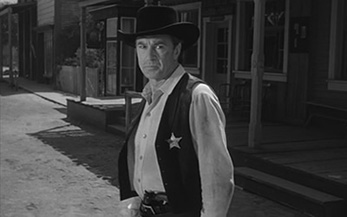Classic Movie Review: High Noon
By Clint Chirpich
January 21, 2016
Westerns have been around since the very beginnings of film, but I have never had very much experience with the genre. Until recently, I'd seen less than 30 true westerns, but I'm making a point to watch more of them, as I quite enjoy most of what I've seen.
One of the first westerns I decided to watch in my quest to broaden my knowledge of the genre was High Noon, the 1952 classic from director Fred Zinnemann and writer Carl Foreman. This is a unique film in many ways, from the themes depicted to the film-making style used.
Gary Cooper plays Hadleyville Marshal Will Kane, who we meet on his wedding day as the ceremony is taking place. He's just wed the beautiful Quaker pacifist Amy Fowler (Grace Kelly) and is turning in his badge so they can leave town and start a new, peaceful life together. Kane learns that Frank Miller - a man Kane captured and sent to be hanged - has been released from prison on a technicality and is on his way, along with his gang of cohorts, back to Hadleyville to seek revenge on the marshal. Miller will arrive on the noon train.
Kane has two options - stay and fight Miller and his gang or leave town as planned. Of course, since Kane is an honorable and proud man, he chooses to stay and stand up against the outlaws. Fowler is upset, with good cause, and threatens to leave with or without him, but Kane doesn't change his mind. He can't bear the thought of Miller running amok through Hadleyville. For most of the film, Kane proceeds to look for help from the townspeople, hoping to deputize as many as possible in order to fight off Miller when the time comes. He runs into problems, though, as most of the people aren't interested in helping him, for various reasons.
High Noon plays out almost in real time. Kane learns of Miller's impending arrival at 10:40 a.m., so he has an hour and 20 minutes to prepare, and the film runs about 65 minutes before the train arrives and Miller is revealed. This film-making choice is interesting and effective as it results in the tension and suspense being ratcheted up each time Kane glances at a clock or at his pocket watch. The audience knows that something terrible is going to happen when the train comes in, and we get to experience the lapse of time right alongside Kane.
There's not a lot of traditional action in High Noon, or at least certainly nowhere near as much as most westerns. When it comes, though, the action is handled extremely well. There's one fist fight and then the climatic shootout. Both scenes are photographed and choreographed in an excellent fashion - they pull you in and keep you engaged. What really intrigued me, though, was the psychological action that fills most of the film. As I said before, Kane spends most of the time speaking with people, trying to get them to join him. Each conversation is like a mental brawl, with Kane fighting for his life. It's excellent stuff, thanks to the writing and performances.
Continued:
1
2
3




